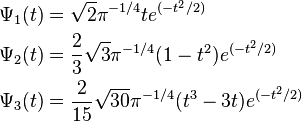Hermitian wavelet
Hermitian wavelets are a family of continuous wavelets, used in the continuous wavelet transform. The  Hermitian wavelet is defined as the
Hermitian wavelet is defined as the  derivative of a Gaussian distribution:
derivative of a Gaussian distribution:

where  denotes the
denotes the  Hermite polynomial.
Hermite polynomial.
The normalisation coefficient  is given by:
is given by:

The prefactor  in the resolution of the identity of the continuous wavelet transform for this wavelet is given by:
in the resolution of the identity of the continuous wavelet transform for this wavelet is given by:

i.e. Hermitian wavelets are admissible for all positive  .
.
In computer vision and image processing, Gaussian derivative operators of different orders are frequently used as a basis for expressing various types of visual operations; see scale space and N-jet.
Examples of Hermitian wavelets:
Starting from a Gaussian function with  :
:

the first 3 derivatives read
and their  norms
norms 
So the wavelets which are the negative normalized derivatives are:

